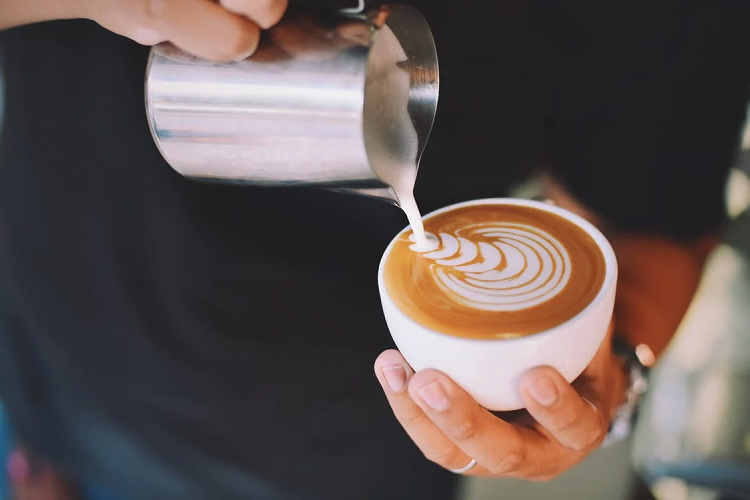Even simple tasks like drinking coffee can be challenging for some of us. On the other hand, if you want flavored coffees but don’t want to add too much cream or sugar, it can be challenging to find a replacement for those two common ingredients. Let’s look at some simple advice that will improve the flavor of your coffee for everybody, regardless of their prior experience.
The flavor of coffee can be affected by a variety of factors. You’ll be able to brew coffee just like they do in cafés in no time at all if you follow these few easy steps. If you use these guidelines, you’ll be able to make coffee taste good every morning. These healthy sweeteners will do the trick if you have trouble making coffee taste good. You’ll give up sugar and cream for good if you’re lucky.
Making delicious coffee at home requires knowledge of the factors contributing to the final flavor. Making excellent coffee is as simple as mastering these variables. This is the sort of information that has to be carefully tracked.
Top 27 Ways on How to Make Coffee Taste Good

1. Add Stevia
When it comes to this alternative to sugar, just a little bit goes a very long way. You only need a few flakes of stevia rather than the standard amount of sugar equivalent to a tablespoon.
2. Add Agave
You only need a fraction of the amount to achieve the same effect because agave is sweeter than sugar. It has a distinct flavor that can be described as comparable to honey.
3. Add Maple Syrup
The versatility of maple syrup extends beyond its traditional use with pancakes. Adding a drop or two of maple essence to your coffee grinds will give it a sweet flavor and give you the warm and fuzzy feeling of a delicious breakfast. Enjoy all your favorite maple flavor without the sticky residue thanks to the extract, which is lower in sugar and significantly thinner than real maple syrup.
4. Use Cold Water
Although you want your coffee hot, cold water produces a superior cup of coffee. Use chilled or, at the very least cool water instead of boiling it. Coffee should never be brewed with water that has been warmed up. Allow your coffee maker to warm it to the most comfortable temperature for your taste buds.
5. Add Almond Milk/Soy Milk/Coconut Milk
Using a dairy substitute allows you to select from various kinds of milk. Compared to traditional milk, dairy substitutes are not only creamier but also slightly sweeter. Almond milk adds a distinct sweetness to coffee, but each variety has its unique flavor.
6. Use Fresh Coffee
Using fresh coffee grounds is arguably the most effective way to improve your cup’s taste rapidly. Try to grind your beans as near to when you intend to use them as feasible. Coffee’s flavor deteriorates over time, with old grinds tasting reasonably acidic.
If you don’t have time to grind once a day, you can better preserve your grinds to stay fresh for longer. Protect them from heat and light by storing them in an airtight container. If you can achieve this, you should notice a difference in the flavor of your coffee.
7. Store them Properly
If you don’t want to buy coffee every day, you’ll need some means to keep your beans organized. Remember to keep them out of the freezer and purchase a container that will retain the air out when they’re in storage. Still, don’t try to keep your coffee in the fridge for too long! Why? Because coffee will always go wrong, no matter what you do.
8. Make Homemade Latte
There’s no need to buy a milk steamer if you want that lovely foamy coffee, Get a milk frother. For less than $20, you can acquire a milk frother that consistently produces gorgeous foam in minutes. Pour warm sugar and milk into your mug and turn on the frother. Add the coffee, and you’ve got yourself a latte!
9. Nut Milk
There is a wide variety of milk from which you can choose to flavor your coffee. If you want a healthy cup of joe, give nut milk a try!
10. Nutmeg
With its earthy flavor and subtle sweetness, nutmeg is an excellent addition to your morning cup of joe. Just a few pods will do; don’t go overboard.
11. Honey
You can’t go wrong with this as a replacement for sugar. It makes your mornings more enjoyable, but it’s also a good source of polyphenols, which are healthful antioxidants.
12. Add to Beans, Not Your Cup
Adding a sweetener or spice like cinnamon, cocoa, or lemon zest to your coffee should be done before the beans are ground. Even if you don’t add any additional ingredients to your coffee after pouring, it will still taste great.
13. Unsweetened Cocoa Powder
Do any of you have a sweet tooth? This post is for you if you fall into that category. Add a teaspoon of unsweetened cocoa powder to your coffee to make a decadent mocha! Just ten calories, yet it provides a rich and luscious flavor to your morning coffee.
14. Iced Coffee
In the heat of the day, nothing beats an iced coffee. Cold brew is an excellent alternative to hot coffee because it is less acidic. Prepare the coffee by soaking the beans for 12 hours in cold water, then draining them well. Enjoy with a few ice cubes.
15. DIY Creamer
The only ingredients in creamer are milk and vanilla extract. So go ahead and save a few more dollars by making your vanilla milk with a few drops of extract.
16. Coffee Ice Cubes
Is there any coffee left in your cup from today? Don’t get rid of it! It’s best to freeze it in an ice cube tray. Use today’s leftovers to make iced coffee for the following day. There are many uses for coffee ice cubes, not only for coffee!
17. Make Dalgona Coffee
This Korean style is trendy right now, and with good reason! Have you given it a shot yet? If you haven’t already, you’re missing out! Two cups of hot water, two tablespoons of instant coffee, and two tablespoons of sugar are combined to form this thick, foamy coffee froth.
The water is crucial here — it must be scalding hot!!! Otherwise, whisking for minutes would exhaust your arm. Enjoy your Dalgona foam on top of any chocolate or milk-based beverage.
18. Vanilla Extract
It’s fantastic for baking, but it also goes nicely with a cup of coffee. Only a modest amount of vanilla extract is needed to avoid the artificial taste of extra coffee vanilla syrup.
19. Cinnamon and Other Spices
Cinnamon and related spices are natural additives to coffee. They add sweetness and a unique taste that you would obtain with sugar. To avoid overdoing it, add a small amount at a time and taste the results.
20. Mint
Mint is an excellent way to flavor coffee. But, because peppermint syrup is mostly sugar, what can you add to get the same flavor without the E-numbers? Peppermint oil is an excellent alternative to syrup. It works well to allow peppermint to dissolve in your coffee while it heats up. A handy tea strainer can help.
21. Lavender and Other Herbs
If you have a tea strainer on hand, you can experiment with additional herbs to enhance the flavor of your coffee. Lavender or essentially anything that smells lovely can make your coffee something less bitter.
22. Salt
Sea salt coffee may appear excessive, but in the appropriate proportions, it may be delicious. Salt numbs the bitter taste buds, giving your coffee a smoother taste and allowing you to perceive its flavors that could otherwise be swamped.
But go easy on this stuff. You only need a quarter of a spoonful. Too much seawater in your coffee.
23. Lemon
Like salt, this is another that helps with harshness. Adding a slice of lemon to your coffee while it’s brewing and cooling helps neutralize the beans’ harshness while also adding a refreshing citrus taste.
24. Butter
This is unusual. The fad of putting butter in your coffee is growing. It used to be a joke for Homer Simpson, but now fad dietitians swear by its energy-boosting properties. It assists in slow digestion, resulting in longer-lasting slow-burn energy rather than the first burst.
The problem is that melted butter in coffee isn’t fantastic unless you enjoy butter. The taste to eat complete sticks of butter at once is required.
25. Clean Your Machine
Stale water and aged coffee grounds are perfect for making coffee taste bad. Make sure to clean your coffee maker regularly and thoroughly. Your coffee will taste fresher as a result of removing old coffee grounds.
26. Do a Trial Run
Some coffee machines can’t correctly heat water when first turned on. This is particularly true with drip coffee machines. No hot water until the second or even third brew. If you want hotter water, try running filtered water first. This will allow it to heat appropriately before brewing your coffee. It will also rinse away any old coffee beans left in the machine.
27. Use Filtered Water
Because coffee is made up of about 99 percent water, it’s critical to use filtered or distilled water when brewing it. Never use tap water, mainly if it contains significant levels of minerals like magnesium, fluoride, and calcium. This is especially true of hard water.
Coffee can benefit from a small amount of these minerals, but too much of them results in a bland cup. As a result, it’s best to stick to filtered water.
The Basics of Great Tasting Coffee
If you want to create great-tasting coffee at home, you need to know what influences the flavor of your brew. You can make better coffee if you have more control over these variables. These are the things you need to keep an eye on.
- The Grind – When it comes to the flavor of your coffee, the grind quality of your beans is a significant factor. They should be the same size; however, they can vary according to the brewing method used.
- Water Temperature – When brewing coffee, the temperature of the water you use significantly impacts the flavor.
- The Steeping time – A few seconds can make a big difference in the flavor of your cup of coffee, even if the steeping period is just a few minutes.
- Ratio – The final flavor of your coffee is greatly influenced by the water-to-coffee ratio.
All of these things can make a massive impact on how you start brewing coffee. You’ve had to know how they all work to make outstanding coffee.
How Does the Grind Affect the Taste of your Coffee?
The physical consistency of your coffee can be attributed to the way it is ground. Here, you can see the particle size of your coffee grinds. Pre-ground coffee does not compare favorably to freshly ground coffee prepared right before serving. It must, however, be precisely the appropriate size.
A coarse grind is needed for French press coffee, a medium-coarse grind is needed for pour-over, a medium-fine grind is needed for Aeropress, and an excellent grind is needed for espresso machines and Turkish presses! All of this and more are explained in great detail in this handbook.
How does Water Temperature Affect Coffee Flavor?
When your coffee is boiling, flavors are dissolved from the grounds into your coffee. The water of a specific temperature is required for this process to succeed. 200 degrees is the optimal temperature for brewing coffee.
If you want to know how hot your coffee is, you can use a low-cost laser thermometer. Remove your kettle of the heat around 30 seconds before you need it, which is a less precise procedure.
How Long Should You Steep Your Coffee?
Flavors and oils are dispersed into the water while the coffee soaks. For maximum flavor extraction, please leave it in there for as long as you can bear to leave it in there. Here, the equation is not as simple as “long time brewing Equals better taste.”
An over-extracting situation occurs when you keep the grinds in the water too long, resulting in a bitter taste. A watery cup of coffee is also the result of under-extracting the beans by not steeping them long enough.
How Does the Coffee-Water Ratio Affect the Taste of Your Coffee?
The water-to-coffee ratio in your brew is a little trickier than it appears. It can influence the amount of time you need to steep your grinds and how the coffee tastes. Because most brewing systems only allow for minor changes, this one must be tweaked in small increments.
With All of That, How Do You Make Coffee Taste Good?
That’s a lot to take in, so how does it affect the taste of your coffee? Balance is vital.
They’re all vital for the end outcome because they affect the taste. A coffee station has all of this figured out. They know exactly what to do for each cup.
To make fantastic coffee at home, try these things. Each must be adjusted progressively until you discover your exact cup.
Guide on How to Make Your Coffee Taste Good
Now that you understand what influences the flavor of your coffee, the next step is to figure out how to make coffee taste good. There is one thing you must do, and that is to approach it methodically.
As mentioned earlier, various factors influence the flavor of your coffee. It’s challenging to figure out where that excellent or poor taste comes from if every cup you prepare has a different collection of these. If you ever create the best cup of coffee you’ve ever had, you won’t be able to duplicate it!
To increase the flavor of your coffee, you must take a more scientific approach to it. Change one thing at a time. Otherwise, remain consistent, and observe the outcomes.
Begin by making coffee the way you usually do or using a good standard recipe. Take notes on how long you soaked the beans, the grinder’s setting, the water-to-coffee ratio, and the water temperature. After that, you can work on improving this recipe.
If your coffee is too bitter, it may have been over-extracted. You can fix this by changing your grinder or steeping time. Shortening the steeping time should reduce the bitterness. Once you’re happy with the results, keep the rest of the recipe the same and focus on the ratio. Adjust the strength of your coffee until it’s ideal.
It’s going to take a long time to implement this system! The most excellent approach to make your coffee taste better is to use this method. Using this method, you have greater control over the flavor of your coffee. Maintaining a level of consistency is critical.
How to Ensure a Flavorful Cup of Coffee?
How can you be sure your coffee will taste excellent every time? How do coffee shops provide the same fantastic flavor every time? Every time is the answer to both queries. Great coffee is a rare find, and each cup is unique.
All you need is consistency and time to find the proper recipe to make outstanding coffee. Of course, superb beans ground fresh are required, but so is uniformity in preparation. Repeat your tests until you get the perfect cup of coffee.
Always use the same water temperature, soaking time, grinder settings, and coffee-to-water ratio. If everything is calibrated correctly, you should receive consistently outstanding coffee.
Conclusion
It’s surprisingly simple to make coffee taste good at home. This is a lot of information to comprehend at first, but it honestly just boils down to thinking through preparing your coffee. Each step can be changed to fine-tune the taste of your coffee completely. However, once you get the hang of it, you’ll be able to replicate the consistently delicious coffee you’ll get elsewhere.



